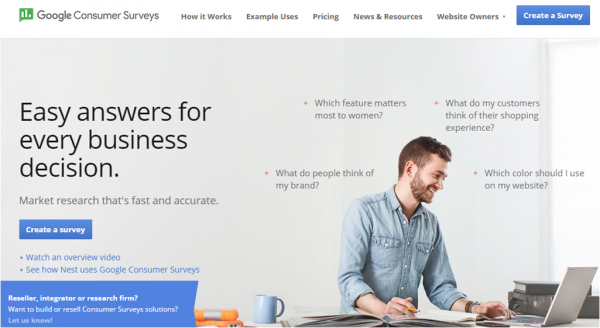
April 25, 2016: Targeted marketing — whether online or offline — works best when you completely understand your targeted audience. Audience research — both quantitative and qualitative — has existed for decades but the internet has revolutionized the practice with the advent of powerful new analytics tools.
Google’s ability to track and analyze massive amounts of user behavior has made it a leader in audience research. At least one 2016 presidential candidate has reportedly used Google’s online survey tool to get feedback on issues, and Google has lately partnered with news organizations, including The Wall Street Journal and the Washington Post, on political polls.
Survey tools for marketers
Google’s primary online survey tool is called Google Consumer Surveys. Launched in 2012, it gives marketers – large and small – the power to ask their audiences what they think and what they want.
A number of use cases are featured for this product, including:
- Product development.
- Market trend analysis.
- Brand tracking
- Campaign measurement
- Customer satisfaction
How it works
Crafting your own survey is easy using Google’s cloud-based survey builder. The first step is to pick your audience demographics. Google lets you draw users from the general population, from its Android platform, or from an audience panel (audience panels are populated using self-reported data from individuals using Google’s Opinion Rewards app).
Once you’ve selected your target audience, write your questions. Google includes 10 different commonly-used survey styles (multiple choice, star-rating, open responses, etc.) For this test survey, I asked a very simple question (“do you like parrots?”) of a U.S.-based audience of people over 55.
After you’ve written your questions, Google will validate your survey.
Here, you’ll confirm the frequency of the survey, the number of responses you want to collect, and the price you’ll pay. In this example, the cost of gathering 500 responses will be $75.00 (500 responses at $0.15 per response). You can change any of these variables, which automatically updates the price. Finally, you can either buy the survey or redeem a coupon offsetting its cost.
Google will distribute your survey via sites who’ve elected to carry it, and the webmasters will be compensated for running it: in fact, Google has a separate program for webmasters seeking to make a little side cash by running surveys. Each site must undergo an application process before being accepted into the program.
Lower-priced survey tools
Google Forms lets you quickly put together single or multiple question surveys and get them on your site. If your site gets a lot of traffic, it’s likely that you’ll be able to gather a lot of audience data in a short period of time.
Whether you’re a big brand looking to compile a lot of opinion data on a product under development, or a local merchant seeking feedback on a website redesign, these two tools can put you on the road to better understanding your audience – which will make all of your marketing smarter, better informed, and more effective.
- 10 Mistakes to Avoid When Using QR Codes for Marketing - September 20, 2023
- Kevin Lee on How AI Changes the SEO Landscape - August 31, 2023
- The Power of Compound Marketing: Kevin Lee Presents @ 1MediaWorld 2023 Global Conference - March 7, 2023
